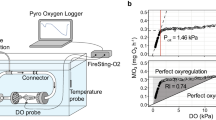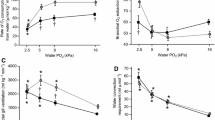Abstract
Respiratory parameters of grass carp were studied during dissolved oxygen (DO) changes from normal DO to hypoxia, then return to normal DO at 15, 25, and 30 °C acclimation, respectively. The results showed that with increases of acclimation temperature at normoxia the respiratory frequency (fR), oxygen consumption rate (VO2), respiratory stroke volume (VS.R), gill ventilation (VG), and VG/VO2 of grass carp increased significantly, but the oxygen extraction efficiency (EO2) of fish decreased significantly (P < 0.05). With declines of DO levels, the fR, VS.R, VG, and VG/VO2 of fish increased significantly at different acclimation temperatures (P < 0.05). A slight increase was found in VO2, and the EO2 of fish remained almost constant above DO levels of 3.09, 2.91, and 2.54 mg l−1 at 15, 25, and 30 °C, while the VO2 and EO2 began to decrease significantly with further reductions in DO levels (P < 0.05). After 0.5 h of recovery to normoxia from hypoxia at three acclimation, the fR, VS.R, VG, and VG/VO2 of the fish decreased sharply; meanwhile, the VO2 and EO2 increased sharply (P < 0.05). The respiratory parameters of fish gradually approached initial values with prolonged recovery time to normoxia, and reached their initial values in 2.5 h at 25 and 30 °C acclimation. The critical oxygen concentrations (Cc) of fish for VO2 were 2.42 mg l−1 at 15 °C, 2.02 mg l−1 at 25 °C, and 1.84 mg l−1 at 30 °C, respectively. The results suggest that grass carp are highly adapted to varied DO and short-term hypoxia environments.


Similar content being viewed by others
References
Beamish FWH (1964a) Respiration of the fish with special emphasis on standard oxygen consumption. II. Influence of weight and temperature on respiration of several species. Can J Zool 42:117–188
Beamish FWH (1964b) Respiration of the fish with special emphasis on standard oxygen consumption. III. Influence of oxygen on respiration of several species. Can J Zool 42:355–366
Cech JJ Jr, Campagna GG, Mitchll SJ (1979) Respiratory responses of largemouth bass (Micropterus salmoides) to environmental changes in temperature and dissolved oxygen. Trans Am Fish Soc 108:166–171
Claireaux G, Chabot D (2016) Responses by fishes to environmental hypoxia: integration through Fry’s concept of aerobic metabolic scope. J Fish Biol 88:232–251
Dong SL, Li DS, Bing XW, Shi QF, Wang F (1992) Suction volume and filtering efficiency of silver carp (Hypophthalmichthys molitrix Val.) and bighead carp (Aristichthys nobilis Rich.) J Fish Biol 41:833–840
Dongmeza EB, Francis G, Steinbronn S, Focken U, Becker K (2010) Investigations on the digestibility and metabolizability of the major nutrients and energy of maize leaves and barnyard grass in grass carp (Ctenopharyngodon idella). Aquac Nutr 16:313–326
Fernandes MN, Rantin FT (1989) Respiratory responses of Oreoclzromis niloticus (Pisces, Cichlidae) to environmental hypoxia under different thermal condition. J Fish Biol 35:509–519
Fernandes MN, Barrionuevo W, Rantin FT (1995) Effects of thermal stress on the respiratory responses to hypoxia of a South American prochilodontid fish, Prochilodus scrofa. J Fish Biol 46:123–133
Greco AM, Gilmour KM, Fenwick JC, Perry SF (1995) The effects of soft water acclimation on respiratory gas transfer in the rainbow trout Oncorhynchus mykiss. J Exp Biol 198:2557–2567
Holeton GF, Randall DJ (1967) The effect of hypoxia upon the partial pressure of gases in the blood and water afferent and efferent to the gills of rainbow trout. J Exp Biol 46:317–327
Hughes GM (1973) Respiratory responses to hypoxia in fish. Am J Zool 13:475–489
Hughes GM, Saunders RL (1970) Responses of the respiratory pumps to hypoxia in the rainbow trout (Salmo gairdneri). J Exp Biol 53:529–545
Hughes GM, Albers C, Muster D, Gotz KH (1983) Respiration of the carp, Cyprinus carpio L., at 10 °C and 20 °C and the effects of the hypoxia. J Fish Biol 22:613–628
Jagdish M, Rana SVS, Agarwal VP (1995) Efficacy of grass carp (Ctenopharyngodon idella) in weed control and its growth in Karna Lake (Haryana). J Inland Fish Soc India 27:49–55
Jensen FB, Nikinmaa M, Weber RE (1994) Environmental perturbations of oxygen transport in teleosts fishes: causes, consequences, and compensations. In: Rankin JC, Jensen FB (eds) Fish ecophysiology. Chapman and Hall, New York, pp 161–175
Jobling M (1982) A study of some factors affecting rates of oxygen consumption of plaice, Pleuronectes platessa L. J Fish Biol 20:501–516
Khan MA, Jafril AK, Chadha NK (2004) Growth, reproductive performance, muscle and egg composition in grass carp, Ctenopharyngodon idella (Valenciennes), fed hydrilla or formulated diets with varying protein levels. Aquat Res 35:1277–1285
Leite CA, Florindo LH, Kalinin AL, Milsom WK, Rantin FT (2007) Gill chemoreceptors and cardio-respiratory reflexes in the neotropical teleost pacu, Piaractus mesopotamicus. J Comp Physiol A 193:1001–1011
Leslie AJJ, Van Dyke JM, Hestand RS III, Thompson BZ (1987) Management of aquatic plants in multi-use lakes with grass carp (Ctenopharyngodon idella). Lake Reservoir Manag 3:266–276
Maxime V, Pichavant K, Boeuf G, Nonnotte G (2000) Effects of hypoxia on respiratory physiology of turbot, Scophthalmu smaximus. Fish Physiol Biochem 22:51–59
Oliveira RD, Lopes JM, Sanches JR, Kalinin AL, Glass ML, Rantin FT (2004) Cardio respiratory responses of the facultative air-breathing fish jeju, Hoplerythrinus unitaeniatus (Teleostei, Erythrinidae), exposed to graded ambient hypoxia. Comp Biochem Physiol A Mol Integr Physiol 139:479–485
Ott ME, Heisler N, Ultsch GR (1980) A re-evaluation of the relationship between temperature and the critical oxygen tension in freshwater fishes. Comp Biochem Physiol 27A:349–355
Rantin FT, Johansen K (1984) Responses of the teleost Hoplias malabarieus to hypoxia. Environ Biol Fish II 3:221–228
Rantin FT, Kalinin AL, Glass ML, Fernandes MN (1992) Respiratory responses to hypoxia in relation to mode of life of two erythrinid species (Hoplias malabaricus and Hoplias lacerdae). J Fish Biol 41:805–812
Rantin FT, Glass MG, Kalinin AL, Verzola RMM, Fernandes MN (1993) Cardio-respiratory responses in two ecologically distinct erythrinids (Hoplias malabaricus and Hoplias lacerdae) exposed to graded environmental hypoxia. Environ Biol Fish 36:93–91
Scott GR, Wood CM, Sloman KA, Iftikar FI, Boeck GD, Almeida-Val VMF, Val AL (2008) Respiratory responses to progressive hypoxia in the Amazonian oscar, Astronotus ocellatus. Resp Physiol Neurobiol 162:109–116
Seibel BA, Childress JJ (2000) Metabolism of benthic octopods (Cephalopoda) as a function of habitat depth and oxygen concentration. Deep-Sea Res 47:1247–1260
Shelton G (1970) The regulation of breathing. In: Hoar WS, Randall DJ (eds) Fish physiology, vol IV. Academic Press, INC, London, pp 293–359
Spitzer KW, Marvin DE, Heath AG (1969) The effect of temperature on the respiratory and cardiac responses of bluegill sunfish to hypoxia. Comp Biochem Physiol 30:83–90
Stecyk JAW, Farrell AP (2002) Cardio respiratory responses of the common carp (Cyprinus carpio) to severe hypoxia at three acclimation temperatures. J Exp Biol 205:759–768
Steffensen JF, Lomholt JP, Johansen K (1982) Gill ventilation and O2 extraction during graded hypoxia in two ecologically distinct species of flatfish, the flounder (Platiehthys flesus) and the plaice (Pleuroneetes platessa). Environ Biol Fish 7:157–163
Tao Y, Kobayashi M, Fukushima H, Watabe S (2007) Changes in rheological properties of grass carp fast skeletal myosin induced by seasonal acclimatization. Fish Sci 73:189–196
Verberk WCEO, Atkinson D (2013) Why polar gigantism and Palaeozoic gigantism are not equivalent: effects of oxygen and temperature on the body size of ectotherms. Funct Ecol 27(6):1275–1285
Vulesevic B, McNeill B, Perry SF (2006) Chemoreceptor plasticity and respiratory acclimation in the zebrafish Danio rerio. J Exp Biol 209:1261–1273
Weiss RF (1970) Solubility of nitrogen, oxygen and argon in water and seawater. Deep-Sea Res 17:721–736
Zhao ZG, Dong SL, Wang F, Tian XL, Gao QF (2011a) The measurements of filtering parameters under breathing and feeding of filter-feeding silver carp (Hypophthalmichthys molitrix Val.) Aquaculture 319:178–183
Zhao ZG, Dong SL, Wang F, Tian XL, Gao QF (2011b) The effect of temperature changes on respiratory response of grass carp (Ctenopharyngodon idellus). Aquaculture 322-323:128–133
Zhao ZG, Dong SL, Wang F, Tian XL, Gao QF (2014) Effect of algae density on breathing and feeding of filter-feeding silver carp (Hypophthalmichthys molitrix Val.) Aquaculture 433:133–136
Acknowledgements
This work was financially supported by China Agriculture Research System (CARS-46), National Program on Key Basic Research Project (2009CB118706), 111 Project of China (B08049), and earmarked fund for the National Science and Technology Support Program (2012BAD25B00).
Author information
Authors and Affiliations
Corresponding authors
Ethics declarations
Conflict of interest
The authors declare that they have no conflicts of interest.
Ethical statement
No ethical issues are involved.
Rights and permissions
About this article
Cite this article
Zhao, Z., Dong, S. & Xu, Q. Respiratory response of grass carp Ctenopharyngodon idellus to dissolved oxygen changes at three acclimation temperatures. Fish Physiol Biochem 44, 63–71 (2018). https://doi.org/10.1007/s10695-017-0413-9
Received:
Accepted:
Published:
Issue Date:
DOI: https://doi.org/10.1007/s10695-017-0413-9




